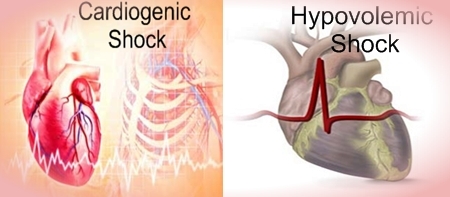Difference between Cardiogenic and Hypovolemic Shock

What is shock?
Shock is a life-threatening circulatory condition that causes tissue hypoxia and circulatory system condition. The cause may be cardiac in origin or non-cardiac. There are several common causes of shock that are known as cardiogenic shocks (e.g. due to acute heart failure or cardiac tamponade), hypovolemic shocks (e.g. after significant blood or excessive fluid) and shocks due to fluid dispersion in the body (septic, anaphylactic, and neurogenic shocks).Patient shows symptoms of low blood pressure, weak pulse, reduced urine and decreased consciousness. Its presentation may be sudden or gradual. Sometimes transfusion is required but sometimes simple fluids administration through intravenous route can be resuscitative. In general, shock has four stages which include initial phase, progressive, compensatory phase and then refractory phase. It is diagnosed clinically and treated according to the cause.
What is hypoxia?
The word hypoxia is a condition in which the tissues are not sufficiently oxygenated, usually due to an inadequate amount of oxygen in the blood. Oxygen deficiency may have serious adverse effects on different body cells that need to conduct essential biological mechanisms.Hypoxia can lead to organ damage and complex metabolic disorders such as kidney failure, DIC (disseminated intravascular coagulation), ARDS (acute respiratory distress syndrome) and circulatory collapse.
Cardiogenic shock
Cardiogenic shock occurs due to decreased output of blood from heart. The most common cause is heart attack, with ventricular failure more dominant. Reduced blood supply to cells causes death of cells. The cause may be damage to heart muscles, valvular diseases and abnormal heart rate. Symptoms are those of a general shock and signs are cold skin with blue color showing cyanosis, added sounds are present with normal respiratory sounds at the base of chest. Heart auscultation also shows added sounds.
Hypovolemic shock
Hypovolemic shock is often a life-threatening condition that occurs when you lose more than 20% (one-fifth) of the body’s blood or fluid supply. This extreme lack of fluid makes it difficult for the heart to pump enough blood into the body. Hypovolemic shock can lead to failure of the organ.
Cardiogenic Vs Hypovolemic Shock
Definition:
- Cardiogenic shock occurs due to reduced pumping of blood by heart into the body.
- Hypovolemic shock occurs due to excessive loss of fluid or blood from the body.
Causes:
- Cardiogenic shock shock is due to failure of ventricles, valvular defects or damage to cardiac muscles. Medications health risks; and factors that prevent flow of the blood freely via the heart, such as a blood clot in the lungs.
- Hypovolemic shock is due to trauma, severe burns vomiting or persistent
-
Symptoms:
Symptoms seen in hypovolemic and cardiogenic shocks include hypotension (reduced blood pressure), tachycardia (increased heart rate), slow pulse, tachypnea (fast breathing), reduced urine production and cold, pale and moist skin.
-
Heart rate:
- In cardiogenic shock heart rate can either be increased or decreased.
- In hypovolemic shock heart rate is always increased owing to the fact that body tries to compensate for the low fluid volume.
-
Jugular venous pressure:
- In cardiogenic shock, jugular venous pressure in neck is high.
- In hypovolemic shock, jugular venous pressure is low.
- Preferred fluids:
- In cardiogenic shock, fluids like ringer lactate are given.
- In hypovolemic shock, inotropic agents are given.
-
Respiratory sounds:
- In cardiogenic shock crackles can be heard at the base of lungs in case of heart failure.
- In hypovolemic shock no crackles are present.
-
Treatment:
- Cardiogenic shock: Fluids and plasma, given by an IV, and drugs to treat cardiogenic shock, work to improve the capacity of the heart to pump. Inotropical agents. You may be given medications to boost the heart rate, such as norepinephrine (Levophed) or dopamine, before other medicines begin to work. Medical procedures to treat cardiogenic shock typically focus on restoring the flow of blood into the heart. They shall include: Angioplasty and surgical procedure includes coronary artery bypass surgery .
- Hypovolemic shock: Management is mostly about preventing the loss of fluid and blood, restoring the loss, and strengthening the damage both caused and induced by the hypovolemic shock. This will also require, if possible, the diagnosis of the accident or disease that caused the shock. These involve the following: blood plasma transfusion.
-
Conclusion
There are four different types of shocks. Two popular varieties are cardiogenic and hypovolemic shocks. The following article provides a brief distinction of cardiogenic and hypovolemic shocks in respect to their symptoms and care. All of them are life-threatening and need immediate treatment.Which is more severe in your opinion?


thanks so much for this info. it was so helpful 🙂
welcome.
SOOOOOOOOOOOOOOOOOOOOOOO HHHHHHHHHHEEEEEEEEEEELLLLLLPPPPPPPPPPPFFFFFFFFULLLLLLLLLL 🙂
I am so happy we could help 🙂